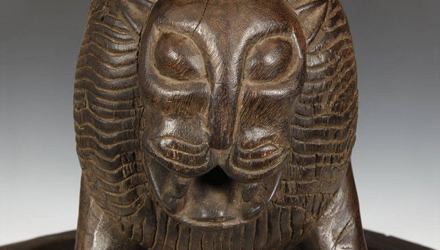Bamileke Lion Stool
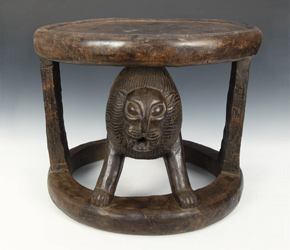 |
|
"The Bamileke people designate stools depicting lions strictly for the Fon, or cheif. There is a Bamileke saying that states, 'Only the chief sits on the lion'"
Almost a century has passed since Matisse, Braque, Picasso, and Vlaminck brought African art into the awareness of the West. Since then, African tribal art has not ceased to arouse interest, and it has now found a secure place in the pantheon of world art. In embarking on a study of African furniture one is almost immediately confronted with the idea that across the continent the tribal peoples did not have a vast furniture repertoire. In other words, they did not make armoires, desks, wardrobes, dressers, and so on (in the western sense). Instead, they made seats, and in this single category they exhibited an almost limitless repertoire.
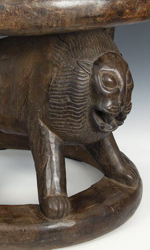 |
|
African seats have exceptional sculptural power; and they range from items incorporating carved figures to extraordinarily abstract forms of a minimalism astonishing even by western standards. Stated simply, in Africa there is an almost endless variety of seats. Each particular group across the continent appears to have a seat endemic to itself, and within a particular style, a wide range of motifs referencing the status and rank of the household where it was found or the individual who used it.
The Bamileke are native peoples living in three regions of Cameroon, namely West, North-West and South-West. Today, they number almost 1,000,000 people, the largest communities or settlements ranging in size from 50,000 to 100,000, collectively known as the Bamileke Kingdom. Bamileke settlements follow a well organized and structured pattern; and these settlements are organized as chiefdoms, each chief known as a Fon. The fon is considered the spiritual, political, judicial and military leader of the chiefdom and is thus accorded great respect. Some Bamileke groups also recognize sub-chiefs, or Fonte. The artistic production of the Bamileke is closely associated with royalty and the ceremonies they conduct. Large figures, prestige objects, thrones and stools are commonly used by the Fon and Fonte to assert power and demonstrate their place in society.
A person's place in the royal hierarchy dictated the type and number of pieces they used; and most art depicts the position of its owner in this hierarchy. For example, in a chief’s residence one would find ancestral figures and masks, headdresses, bracelets, pipes, necklaces, swords, horns, fans, elephant tusks, leopard skins, terracotta pots, dishware, and seats, all used to assert the chief’s power. In the home of a Fonte one might find similar objects, but fewer in number and of less importance. In the home of a non-royal dignitary, one would also find a range of objects, but more utilitarian in nature. All of these objects were put to use during rituals such as funerals, festivals, and a host of ceremonies and rituals related to numerous societies found within the Bamileke kingdom.
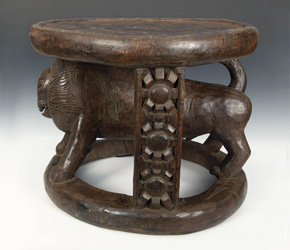 |
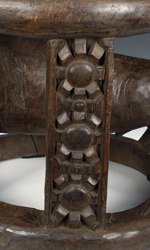 |
the spider |
|
Most Bamileke figural art represent the chief; and seats (in particular) were the prerogative of royalty. Only a ruler could sit on a seat depicting an animal, for one ancient belief among the Bamileke was that the Fon had supernatural powers enabling him to turn into an animal (elephant, buffalo, lion, leopard, etc.). It can be said with certainty this stool was intended for use by the Fon because the Bamileke people considered the lion to be the supreme symbol of the authority of the Fon. Consequently, it could be interpreted as saying, “Only the chief sits on the lion;” or “The chief and the lion are the same;” or “The chief speaks with the authority of the lion;” or any variation of this theme. This was not a stool made for use by non-royalty.
Another aspect of this stool that is highly noteworthy is the side supports, and to understand what they mean it is necessary to look into the religious practices of the Bamileke. To the Bamileke, ancestor veneration is an integral aspect of society. Like many other African tribes, they believe past generations are capable of providing guidance to the living if they can be heard, and for the Bamileke, communication with the ancestors is done primarily through “sages” like the Fon. One important Bamileke belief is that the ancestral world lies deep within the earth. In other words, the earth is the home of the ancestors, the place where the deceased continue to live. Consequently, many Bamileke stools and thrones depict ancestors or their intermediaries; the most famous being spiders, a creature serving as the link between the living and the dead because it burrows into the ground. The side supports of this stool are meant to illustrate stylized spiders. Consequently, one further interpretation of the stool is “The chief speaks the wisdom of those who have come before with the authority of a lion.”
Download this Article: Bamileke Lion Stool.pdf
